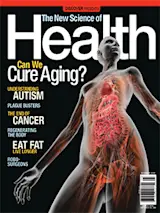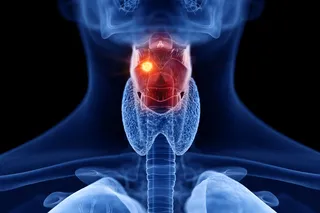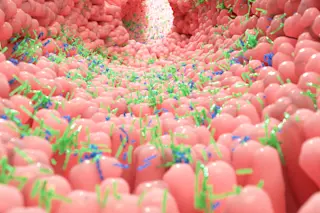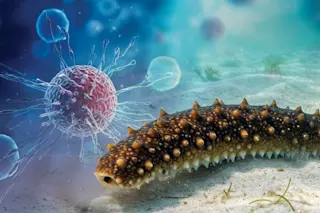Most current research into the causes of cancer focuses on genes and environmental triggers. Evolutionary biologist Paul Ewald of the University of Louisville in Kentucky argues that scientists have overlooked the most important cause: parasites, especially viruses. Blending medicine and Darwinian biology, Ewald considers cancer and other diseases from the pathogen’s point of view, showing how natural selection determines why the smallpox virus, for instance, is a ruthless killer while viruses for the common cold are relatively benign. He says that once we identify the viruses that trigger cancer, we can work to prevent their transmission and force them to evolve from fatal scourges into mere nuisances, eventually turning cancer into a manageable disease.
DISCOVER: What is new about the way you are thinking about disease?Paul Ewald: I apply Darwinian principles to medicine with the goal of solving problems. Medicine is not very good at addressing evolution, and to me that’s a great problem in regard to infectious disease. Humans barely evolve quickly enough to adjust to rapidly evolving infectious agents.
D: Why do you believe that viruses lie behind many types of cancer?PE: To progress toward cancer, you need a few specific genes to be mutated, within a limited number of cell divisions, to cause the cells to divide uncontrollably. But if you mutated almost any of the other 30,000 genes, the cells would die or be crippled. So how do all those specific mutations occur so rapidly without destroying the cells? It turns out that each virus that’s been studied and associated with cancer—such as hepatitis B with liver cancer or human papilloma virus with cervical cancer—evolves characteristics that allow it to target those genes immediately upon infection. They’re pushing cells to the brink of cancer because the cells will grow faster with the virus embedded inside and won’t be able to stop dividing. These viruses don’t really benefit if you get cancer, but they do benefit when the viral genome can replicate and persist despite a sophisticated immune system.
D: How much cancer is caused by viruses or other infectious agents?PE: If I were going to put my money on it, I would bet that by 2050—hopefully earlier—we’ll have found that more than 80 percent of all human cancer is caused by infection. The number could be as high as 95 percent. In 1975 it was considered to be zero.
I would bet that by 2050 we’ll have found that more than 80 percent of all human cancer is caused by infection. In 1975 the number was considered to be zero.
D: So are genes and environment not as important as most researchers think?PE: Viruses push cells to the brink; additional mutations from genetic defects or the environment are needed for full-blown cancer. Keep in mind that the vast majority of mutating agents provoke cells to stop functioning or to die, meaning there is no chance for those mutations to cause cancer. Without an infection, the few mutated cells that could potentially cause cancer stop proliferating after several divisions. But infected cells can reach such high numbers that the progression to cancer is not terminated by the many mutations that kill the cells or make them nonfunctional. The small percentage that are cancer-causing can continue to proliferate.
You can test this idea by looking at the earliest stages of dysregulation. You should find that the virus is always there, but you’re not going to find the mutations that we know are associated with that cancer. That has been done with cervical cancer. If you look at the very early stages, the virus is always there, but the mutations are there only maybe 10 percent of the time.
D: How do we get infected with these dangerous pathogens?PE: Two of the most powerful examples are sexual transmission and kissing transmission, and by that I mean juicy kissing, not just a peck on the cheek. If you think about these modes of transmission, in which it might be a decade before a person has another partner, you realize that rapidly replicating is not very valuable—the winning strategy for the microbe would be to keep a low profile, requiring persistent infections for years. So we would expect that disproportionately, the sexually transmitted pathogens would be involved in causing cancer, or chronic diseases in general. You can test this. Just look at the pathogens that are accepted as causing cancer—Epstein-Barr virus, Kaposi’s sarcoma–associated herpesvirus, human T lymphotropic virus 1—and find out whether they’re transmitted this way. They almost all are. A random sample would yield maybe 15 to 20 percent of pathogens associated with cancer being sexually transmitted, yet the figure is almost 100 percent. When you look at viruses alone, it is 100 percent.
D: In the future, could we fight cancer by controlling the evolution of viruses and other pathogens?PE: If a parasite depends on host mobility for transmission, then natural selection will favor milder parasites. An example is malaria. If we make houses and hospitals mosquito-proof, then we make it so that the only people who can be a source for mosquitoes are the people who are healthy enough to move around outside. So they’re going to have milder strains, and we expect the pathogens that evolve to be mild. In terms of cancer, I think that preventing infections in the first place will be the most effective intervention in a multipronged prevention strategy. If we know the routes by which these pathogens are very likely transmitted, people can reduce their exposure. We can develop vaccines—the cervical cancer ones provide a model. We can screen blood supplies, as is now being done to prevent liver cancer caused by hepatitis B and C viruses. And we can generate increasingly effective antiviral therapies. And the same interventions that you would use to avoid being infected will also, according to theory and available data, reduce the likelihood that these agents, if you are infected with them, will cause cancer. I would expect to be able to cut health-care costs by 80 percent and provide much better care because we will be preventing these diseases.














